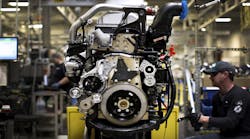Business optimism is surging to record highs in the U.S. as the nation’s economy appears to gaining “solid footing,” according to the results of two surveys released this week.
According to the second quarter update to the 2017 Equipment Leasing & Finance U.S. Economic Outlook issued by the Equipment Leasing & Finance Foundation (ELFA), equipment and software investment is expected to improve in 2017 after a “lackluster” 2016 as renewed business confidence and firming energy prices lift the potential for business investment and capital expenditures while reducing uncertainty.
“Our forecast for an improving equipment finance sector is based largely on actions coming out of Washington that indicate a more business-friendly approach by the new Trump Administration, the recent move by the Federal Reserve to gradually increase short-term interest rates, and early indications of a steadily growing economy,” noted Ralph Petta, the ELFA’s president and CEO, in a statement.
“It is our hope that these factors do in fact provide impetus for the equipment finance industry this year to outperform 2016,” he added.
Highlights from the study include:
- The U.S. economy appears to be on solid footing, despite an underwhelming finish to 2016 and slow start in 2017.
- Business investment and manufacturing activity continue to lag, but industry confidence indices point to an improved investment picture during the second half of the year.
- Overall, the U.S. economy is projected to grow 2.5% in 2017—similar to 2014 and 2015, but a significant improvement over 2016.
- For example, the ELFA noted that equipment and software investment is expected to grow by 2.8% in 2017, a significant improvement over the -1.1% contraction in 2016.
- Meanwhile the group said investments in trucks should “continue to strengthen.”
- Bolstered by a tightening labor market, healthy consumer spending, improved growth in international markets and the potential for broad-based domestic regulatory reform, the U.S. economy has reason for cautious optimism in 2017.
- However, economic headwinds, including risks associated with weak export growth, industrial sector sluggishness and government gridlock should temper expectations.
However, according to the latest International Business Report compiled by market research firm Grant Thornton – a report based on a poll of 2,400 companies within 36 different economies – business optimism in the U.S. has surged to a record high of 80%, suggesting that the “new pro-business U.S. administration” is acting as a “catalyst,” releasing pent-up confidence after a long period of supportive monetary policy and cheap oil.
Although the U.S. dollar has come off its recent high, Francesca Lagerberg, global leader of tax services at Grant Thornton, noted in the report that the dollar remains strong at a time of relatively low-cost financing and healthier global growth.
“As the world’s largest economy, U.S. business confidence sends a shot of endorphins throughout the global market. It’s encouraging, therefore, to see that close neighbors and countries with strong trade links are also riding a new wave of hope,” she said.
“But clearly U.S. businesses are not yet seeing or expecting this to result in bottom-line change over the short term,” Lagerberg added. “Businesses await follow-through on promises relating to spending, de-regulation and tax cuts, while stock markets continue to react to daily policy developments.”
Globally, she added that business optimism is at its highest level on record – 49% – heading in to the second quarter of 2017. Neighboring countries feel upbeat, too, as optimism increased in Canada from 33% to 59% and in Mexico from 8% to 32%.
Globally, export expectations are up from 16% to 18% over the past three months, with data revealing global hikes in expectations for investment in plants and machinery to 34% (up a percentage point) and for new buildings to 22% (up three percentage points).
“Growth in U.S. investment expectations are clearly opening up opportunities for trade,” Lagerberg pointed out. “In light of this, businesses should assess their export strategies over the coming years and consider how to take advantage of where investments are likely to strengthen.”
However, U.S. optimism is not yet feeding through into other business fundamentals, she cautioned, as U.S. business expectations for revenue and profitability declined from 58% to 52% and from 55% to 52%, respectively.
“Though firms in many parts of the world are feeling positive, concern over a lack of skilled staff is at a two-and-a-half year high of 33%, while global hiring expectations have also risen from 29% to 32%,” Lagerberg emphasized. “This is a particular problem in tight labor markets, where businesses that don’t provide above-inflation wage growth may soon find their workers looking elsewhere.”



